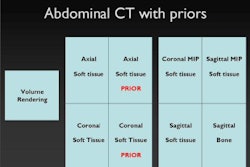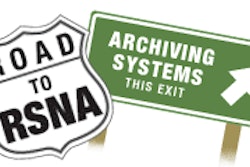An enterprise patient index (EPI) is an effective means of facilitating a multihospital PACS network, according to researchers from Maine Medical Center (MMC) in Portland, ME.
"It's an (effective) way for pulling information from multiple organizations," said Robert Coleman, director of radiology informatics at MMC. He presented the institution's experience with developing a regional consolidated imaging record at the Society for Computer Applications in Radiology (SCAR) 2006 annual meeting in Austin, TX.
MMC is a 600-bed hospital that performs 180,000 exams a year. It's part of MaineHealth, a health system that owns three "member" hospitals and is affiliated with five other hospitals.
Although part of or affiliated with MaineHealth, each organization determines its own IT strategy; most MaineHealth initiatives are optional, Coleman said.
"There's no top-down control," he said. "What that means is a very heterogeneous environment. We have different HIS systems at each hospital, different RIS systems, and different patient identifiers."
MaineHealth performs approximately 330,000 exams per year, 150,000 of which are non-MMC studies.
"By the middle of next year, we'll actually be archiving more studies from other organizations than (MMC)," Coleman said. "It's becoming truly a regional or shared PACS across many organizations."
EPI
An EPI, also known as an enterprise master patient index, is essentially a database that connects patients/patient identifiers from disparate organizations. Each patient is assigned an EPI number. This number, which is generally not visible to users, provides matching and merging capability.
There are two EPI strategies: an "active" front-end approach, in which the EPI is checked in real-time at the time of patient registration, or a "passive" back-end model that involves EPI lookup downstream via interfaces, Coleman said.
In the front-end EPI approach, each organization is required to significantly modify its registration process, he said.
"In our environment, that was something that we were unable to do," he said. "It was just too big of a challenge."
Instead, MaineHealth opted for the passive back-end EPI approach, which allows each institution to keep its own registration process. "Close" matches do need to be reviewed by central EPI staff and merged if appropriate, Coleman said.
MaineHealth faced some EPI challenges, including the lack of participation in the EPI by all organizations, he said. Integration can be difficult, and the EPI vendor also charges to add each organization.
"We basically had to make it an option, and not everybody chose to use our EPI," he said. "They all chose to use the PACS obviously."
In addition, many of the sites didn't have HL7 capability, and their radiology IT systems were not EPI-aware, Coleman said. Also, there was no effort to historically preload the EPI with all of the patient data.
Interface engine
To handle these problems, MaineHealth implemented its own HL7 interface engine, which enables the various interfaces to accommodate the idiosyncrasies of the different hospital and radiology information systems in use, Coleman said. The health system also partnered with its new RIS vendor to enhance EPI functionality within the RIS and develop an integration strategy to accommodate EPI participants and those not participating in EPI, as well as interfaced sites and sites using "manual" interfaces.
For MaineHealth EPI participants, EPI numbers were obtained from the ADT information being passed from the hospital information systems, Coleman said. For non-EPI participants, the RIS and its EPI functionality were used to manage the multiple patient identifiers.
"For example, the same patient may have two different IDs, but the RIS was able to link them together using the EPI," he said. "We used the RIS to send the HL7 message to the EPI, obtained a match, and pulled the data back."
A single PACS domain ID was also created in the EPI. The RIS/PACS is treated as its own domain in the EPI, Coleman said.
"What that allows us to do is use the EPI to record a unique PACS domain identifier, which we actually use in the PACS to pull all the information together from the various hospitals," he said.
For sites without HL7 capability, registration info is manually entered in the RIS. The RIS sends the ADT information to the interface engine, which queries the EPI. The EPI number is then assigned and sent back to the RIS.
This approach solved most of the issues, Coleman said. All organizations were able to use their own patient IDs, with the exception of the PACS network and Web system. Those systems required a unique patient identifier for each patient.
"What we wound up doing is prefixing patient IDs with a unique character," he said. "This turned out to not be such a bad problem because for the most part, in the PACS systems and on the Web, clinicians do not usually do patient ID searches."
One challenge that remains with the passive EPI approach is the delay in patient matches. Sometimes it takes a few hours for somebody to determine if they are in fact a match, Coleman said.
"We are looking at some ways to proactively notify people that there's an important match that needs to be looked at," he said.
Coleman recommends buying IT systems that fully support EPI numbers and implementing, if possible, an "active" EPI approach. "It's much easier overall," he said. "The challenge there, of course, is getting the registration departments to change. If you can do it, I'd recommend that."
Also, be sure to clean up your dataset and preload as much historical data as you can into the EPI, Coleman said. And don't assign temporary EPI numbers.
In addition, keep interface design as simple as possible, and handle all domains in the same way, he said. And make sure to build a robust EPI infrastructure; your EPI will become as important as your PACS network.
"Just make sure to understand getting into this that the interface requirements are relatively complex," Coleman concluded.
By Erik L. Ridley
AuntMinnie.com staff writer
June 28, 2006
Related Reading
EMR proves profitable for multispecialty practice, May 24, 2006
Digital dashboard aids radiology workflow, April 28, 2006
Defining PACS policies and procedures, April 19, 2006
Workflow analysis yields process improvements, March 17, 2006
Digital dashboard eases radiology IT operation, March 16, 2006
Copyright © 2006 AuntMinnie.com



















